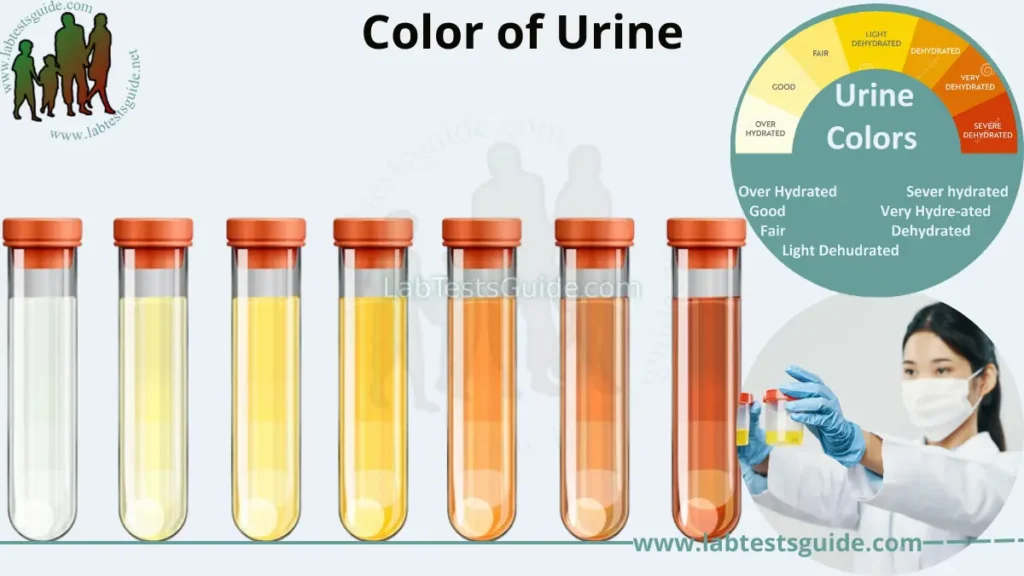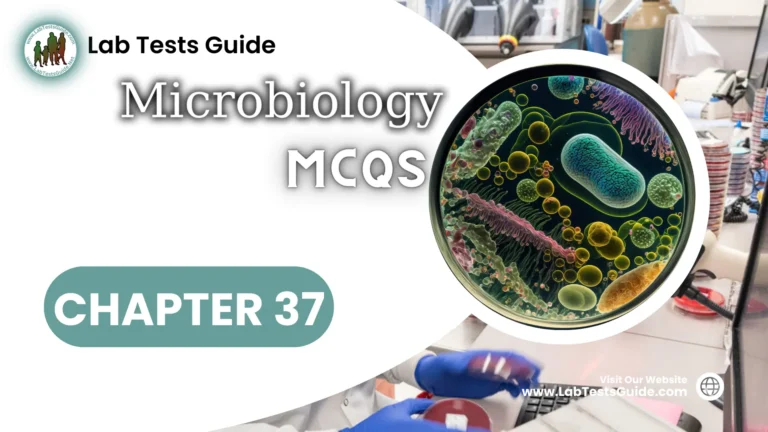Urine physical properties refer to the observable characteristics of urine that can be measured or assessed, such as color, odor, transparency, pH level, specific gravity, and volume. These properties can provide important information about a person’s overall health and hydration status, and can be used to help diagnose and monitor various medical conditions. For example, changes in urine color or specific gravity can be a sign of dehydration, while cloudiness or a strong odor may indicate the presence of an infection or other medical condition. A physical examination of urine involves analyzing these properties to provide a diagnosis and treatment plan.

Here are some of the key physical properties of urine:
- Color: Urine can range in color from pale yellow to dark amber, depending on a person’s level of hydration and other factors.
- Odor: Urine can have a slight odor, but if it has a strong, foul smell, it may be an indication of an underlying medical condition.
- Transparency: Normal urine is typically clear and transparent, but if it appears cloudy or murky, it may indicate the presence of bacteria, blood, or other substances.
- Volume: The average volume of urine produced by an adult is between 800 to 2000 ml per day.
It’s important to note that changes in any of these physical properties can be a sign of an underlying medical condition, and should be discussed with a healthcare provider.
Type of urine samples:
- Random sample:
This is a diluted urine sample and may give an inaccurate interpretation of patient health. But is best to do microscopy to evaluate WBC or RBC. - First Morning sample:
This is the best sample for microscopy and urine analysis. This is the concentrated urine because of urine remained throughout the night in the urinary bladder. This will contains an increased concentration of analytes and cellular elements. Urine must have remained in the bladder for 8 hours is considered as the first-morning sample. - Urine for sugar (Postprandial 2 hours):
Postprandial 2 hours sample collected after 2 hours of high carbohydrate diet. - Midstream clean catch urine:
This sample is needed for the culture and sensitivity of urinary infection. The patient is advised to clean the urethra, then discard the first few mL of urine. Now midstream of the urine is collected in the sterile container. - 24 Hours of a urine sample
- In this case, discard the first urine and note the time.
- Now collect urine in the container for 24 hours and put the last sample in the container.
- Refrigerate the sample.
- This 24 hours samples are needed for measuring urea, creatinine, sodium, potassium, glucose, and catecholamines.
- Suprapubic collection of the urine sample:
This is done in the patients who cannot be catheterized and the sample is needed for culture. This sample is collected by the needle. - Catheter collection of urine:
This is done by patients who are bedridden and can not urinate. - Pediatric urine sample:
In infants, special collection bags are made adherent around the urethra. Then urine is transferred to a container.
Urine Physical Properties:
A physical examination of urine involves analyzing its various physical properties to provide information about a person’s overall health and hydration status. Here are some of the key components of a physical examination of urine:
- Color: The color of urine can be assessed visually and compared to a standardized color chart to determine if it falls within the normal range.
- Odor: The odor of urine can be assessed by smelling a sample of the urine, and any unusual or strong odors can indicate an underlying medical condition.
- Transparency: The transparency of urine can be assessed visually, and any cloudiness or turbidity may indicate the presence of bacteria, blood, or other substances.
- Volume: The volume of urine produced can be measured over a specific period of time, and a normal range is between 800 to 2000 ml per day.
Volume of Urine:
- It is 600 to 2500 ml /24 hours and the average volume is 1200 ml/ 24 hours.
- Polyuria when urine amount exceeds 2000 mL/ 24 hours.
- This is seen in diabetes mellitus.
- In diabetes Insipidus.
- Excessive fluid intake.
- Drugs like diuretic therapy.
- Oliguria when urine volume is less than 500 mL/ 24 hours. This is seen in the following conditions.
- Renal tubular dysfunction.
- Edema.
- End-stage kidneys.
- Obstructive uropathy.
- Dehydration.
- Vomiting.
- Shock.
- Diarrhea.
- Anuria when there is no urine output. This is seen in the following conditions.
- Acute renal failure.
- Heart failure.
- Acute Glomerulonephritis.
- Obstructive uropathy.
- Shock.

Color of Urine:
- Normal color is Pale to dark yellow.
- Abnormal Color may be due to some of the foods and medicines.
- Urine with no color may be caused by long-term kidney disease or uncontrolled diabetes.
- Dark yellow urine can be caused by dehydration.
- Red urine can be caused by blood in the urine.
- The Orange color is due to bilirubin.
- The dark yellow color may be seen due to bilirubin and urobilin.
- Brown and black color may be seen due to melanin, homogentisic acid and biliary pigments.
- Green color urine may be seen due to Biliverdin, pseudomonas infection and oxidized bilirubin.

The abnormal color is seen in:
- Cloudy urine can be caused by :
- pus (white blood cells).
- Blood (red blood cells).
- Sperm, Bacteria, and yeast.
- Crystals.
- mucus.
- Parasite infection, such as trichomoniasis.
- Red color urine may be:
- Clear, this will indicate:
- Hemoglobinuria.
- Myoglobinuria.
- Red cloudy urine indicates:
- Hematuria.
- Clear, this will indicate:
Clarity of urine:
- Normally it is Clear. No visible particles are seen.
- Hazy urine where there are few particulates and through urine, print can be seen easily.
- Cloudy when there are many particulates and through urine, the print is blurred.
- Turbid urine when through urine print cannot be seen.
- Milky where there are many particulates and it may be clotted.
- Urine turbidity is seen in nonpathological conditions like:
- With the presence of squamous epithelial cells.
- The presence of mucus.
- The presence of spermatozoa.
- Amorphous phosphates, urates, and carbonates.
- The case of contrast media.
- The case of fecal contamination.
- Urine turbidity is seen in the pathological conditions like:
- Red blood cells.
- Presence of bacteria.
- Presence of yeast.
- Abnormal crystals.
- Lymph fluids and lipids.

Odor:
- Normally odor is a slightly “nutty” odor (faint aromatic odor).
- On keeping the urine the ammonia odor is more prominent. This is because of the breakdown of the urea.
- Abnormal Odor may be due to:
- Some foods (such as asparagus), vitamins, and antibiotics (such as penicillin) can cause urine to have a different odor.
- A sweet, fruity odor may be caused by uncontrolled diabetes mellitus.
- A urinary tract infection (UTI) can cause a bad, unpleasant odor.
- Urine that smells like maple syrup means maple syrup urine disease when the body cannot break down certain amino acids.
- Phenylketonuria gives a mousy smell.
- Bleach like odor is due to contamination.
Normal Urine Findings:
Here is a table of normal urine findings:
| Characteristic | Normal |
|---|---|
| Color | Pale or yellow |
| Appearance | Clear |
| Odor | Mildly aromatic |
| Volume | 1200 to 2000 ml/24 hours |
| pH | 5 to 7 |
| Specific gravity | 1.001 to 1.035 |
| Cast (hyaline) | 0 to 5 / HPF |
| Red blood cells | ≤ 3 / HPF |
| Blood | Negative Rarely 2 to 3 RBCs/HPF |
| White blood cells | ≤2 to 5 HPF Male = 1 to 2 /HPF Female = 0 to 5 /HPF |
| Squamous epithelial cells | ≤ 15 to 20 / HPF |
| Yeast | Negative |
| Bacteria | Negative |
| Protein | Negative |
| Glucose | Random sample = Negative 24 hours sample = 1 to 15 mg/dL |
| Ketones | Urine = Negative |
| Bilirubin | Negative (o to 0.02 mg/dL) |
| Urobilinogen | Negative Random sample= <1 mg/dL 2-hour sample = <1 mg /2 hours 24- hours sample = 0.5 to 4.0 mg/dL |
| Nitrite | Negative |
| Albumin | 10 to 100 mg /24 hours |
| Protein | Quantitative = negative Urine 24 hours sample: Adult male = 1 to 14 mg/dL Adult female = 3 to 10 mg/dL Child <10 years = 1 to 10 mg/dL |
| Calcium | Normal diet = 100 to 300 mg/24 hours Low-calcium diet = 50 to 150 mg/24 hours(Another source = 0.3 g/24 hours) |
| Sodium chloride | average 10 g /24 hours Patient with moderate to severe salt depletion = <10 mmol/L or <20 mmol/L /24 hours(Another source = 15.0 g/24 hours) |
| Sodium | Adult = 40 to 220 meq/24 hoursChild = 41 to 115 meq/24 hours |
| Potassium | Adult = 25 to 125 meq/ 24 hours Child = 10 to 60 meq/24 hours(Another source = 3.3 g/24 hours) |
| Magnesium | 75 to 150 mg/24 hours(Another source = 0.1 g/24 hours) |
| Bicarbonate | Negative |
| Creatinine | Male = 20 to 28 mg/Kg/24 hours Female = 15 to 21 mg/Kg/24 hours(Another source = 1.5 g/24 hours) |
| Urea nitrogen | 5 to 15 g/24 hours |
| Nitrogen | 7 to 20 g/24 hours |
| Urea | 10 to 35 g/24 hours(Another source = 25.0 to 35.0 g/24 hours) |
| Uric acid | With normal diet = 250 to 750 mg/24 hours With purine-free diet = <400 mg/24 hours With high-purine diet = <1000 mg/24 hours(Another source = 0.4 to 1.0 g/24 hours) |
| Urobilinogen | 0.2 to 4.0 mg/24 hours |
| Chloride | Adult = 110 to 250 meq/24 hours Child: <6 years = 15 to 40 meq/24 hours Child: 10 to 16 years = 64 to 176 meq/24 hours |
Possible References Used



